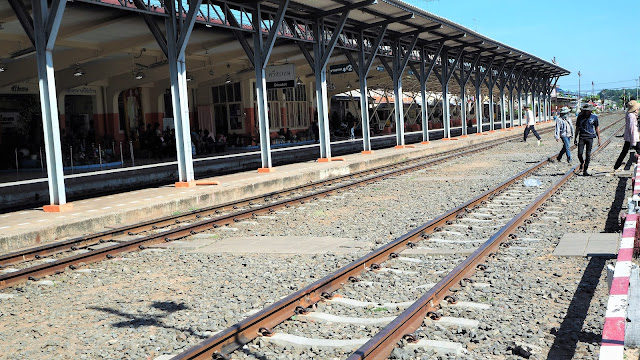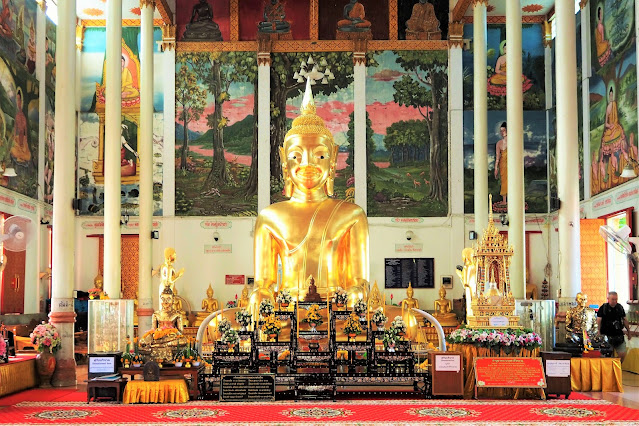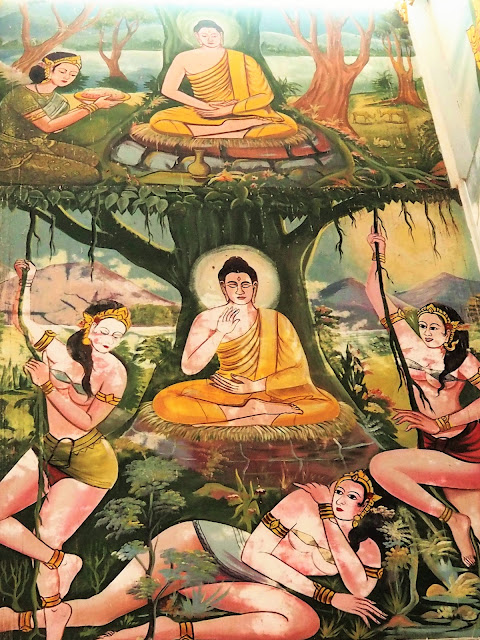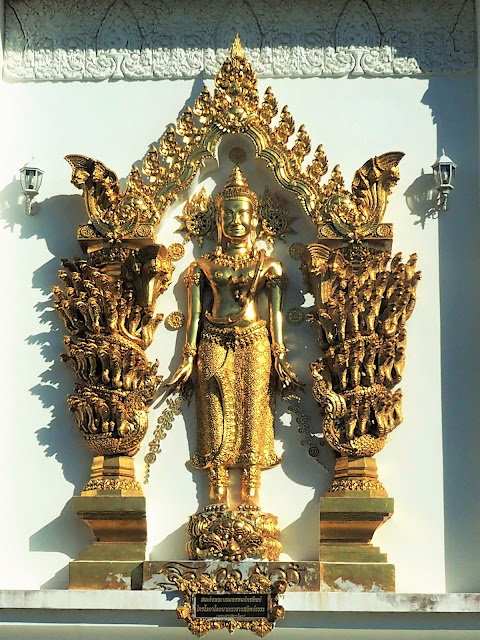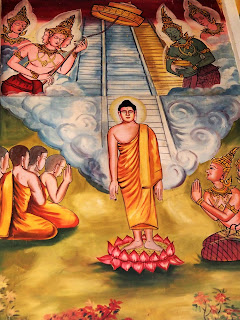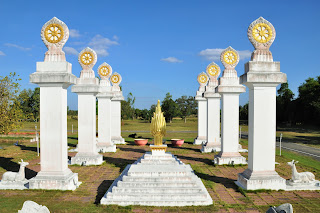North-Eastern (I-San) Thailand and Laos, 16 Nov - 10 Dec 2015 (25days)
Si Sa Ket bus station.
Day 14 (29.11.2015) Ubon Ratchathani to Si Sa Ket (67km)
On day 14 after breakfast at 9.30am we took a van to Si Sa Ket (again we have to buy additional seat for our luggage). At 10.40am we arrived at the bus station. From the bus station, we walked through the town to get to our hotel. We then walked over the train station nearby to visit Wat Maha Buddharam and later took a taxi to Wat Nong Takian which is 19km south of Si Sa Ket. At night we walked along the night market right in front of our hotel and besides the railway station.
Sleeping at Prompiman Hotel, Si Sa Ket.
Sleeping at Prompiman Hotel, Si Sa Ket.
Si Sa Ket train station is 547 km from Bangkok.
Si Sa Ket train station is 547 km from Bangkok.
Phra Nang Sri Sra Phom
Phra Nang Sri Sra Phom - On a traffic roundabout, is a statue of a woman bathing, and washing her hair.
Phra Nang Sri Sra Phom - This statue constructed in 1981 represents the ancient Kymer princess Sri, who prepared herself in this manner in order to dance before and to worship the god Vishnu.
Wat Maha Buddharam is the most famous temple of Si Sa Ket City located not far from the train station.
Wat Maha Buddharam is the most famous temple of Si Sa Ket City located not far from the train station.
Wat Maha Buddharam of Si Sa Ket City has 3 entrances by 3 different streets.
Wat Maha Buddharam, Si Sa Ket.
Wat Maha Buddharam, Si Sa Ket.
Wat Maha Buddharam, Si Sa Ket.
Wat Maha Buddharam, Si Sa Ket main Wihaan is guarded by two large stone colossi.
Wat Maha Buddharam, Si Sa Ket main Wihaan is guarded by two large stone colossi.
Wat Maha Buddharam, Si Sa Ket.
Wat Maha Buddharam, Si Sa Ket Wihaan you can see the beautiful paintings depicting the life of Buddha.
Wat Maha Buddharam also houses the Luang Phor To, a very sacred Buddha image for the people of Si Sa Ket. This large Buddha statue 6.85 meters high and 3.50 meters wide was built during the Khmer period more than 100 years ago.
Beautiful paintings depicting the life of Buddha at Wat Maha Buddharam, Si Sa Ket.
In the year 624 BC, in Kapilawaththu (Nepal) Siddhartha Gautama was born as a prince. His father was King Suddhodana and his mother was Queen Mahamaya. When he was sixteen he finished his education and he married Princess Yasodara. King Suddhodana handed over his kingdom to his son Siddhartha.
They had a baby name Rahula. When king Siddhartha was 29 years old he decided to renounce lay life.
Siddhartha left from his kingdom and went to several well-known teachers to study the ultimate nature of reality. But their teachings didn’t satisfy him and he set out to find his own path.
Six years later he went to Bodgaya near the Neranjana River and sat under a tree.
Siddhartha's mind was calm and relaxed. As he sat his concentration deepened and his wisdom grew brighter. In this clear and peaceful state of mind he began to examine the true nature of life. "What is the cause of suffering,” he asked himself, “and what is the path to everlasting joy?" In his mind's eye he looked far beyond his own country, far beyond his own world. Soon the sun, planets, the stars out in space and distant galaxies of the universe all appeared to him in his meditation. He saw how everything, from the smallest speck of dust to the largest star was linked together in a constantly changing pattern: growing, decaying and growing again. Everything was related. Nothing happened without a cause and every cause had an effect on everything else.
As he realized this, deeper truths appeared to his mind. He looked deeply into himself and discovered that his life as Siddhartha the Prince was but the latest in a series of lifetimes that had no beginning - and that the same was true of everyone. We are born, live and die not one time, but again and again. He saw that death is only the separation of the mind from its present body. After death the importance of Karma is central to the next journey. When one life ends, another begins - and in this way the wheel of death and birth keeps spinning around and around. He also saw one life to the next we are constantly changing and constantly affecting one another. Sometimes we are rich and comfortable; sometimes we are poor and miserable. Occasionally we experience pleasure, but more often we find ourselves with problems. And Siddhartha also saw that as our conditions change, so do our relations with others. We have all been each others friend and enemy, mother and father, son and daughter thousands upon thousands of times in the past.

Then he looked at all of the suffering in the world. And he saw how living beings create their own misery and joy. Blind to the truth that everything is always changing, they lie, steal and even kill to get the things that they want, even though these things can never give them the lasting happiness they desire. And the more their minds fill with greed and hate, the more they harm each other - and themselves! Each harmful action leads them to more and more unhappiness. They are searching for peace yet find nothing but pain. Finally, he discovered the way to end all this suffering. He was filled with a radiant clear light. He was no longer an ordinary person. With a calm and peaceful smile, he arose from his meditation. In the golden daybreak, so it is said, Siddhartha looked up and saw the morning star. And then a great understanding came to him. He saw in his mind all the life of the world and the planets; of all the past and all the future. He understood the meaning of existence, of why we are here on this earth and what has created us. At long last he found the truth; he attained enlightenment and established the principles of Karma. Now he was the Lord Buddha, the fully liberated one, awakened and enlightened. The search of six long years had ended. It was a day when the full-moon shone, casting a bright silver light on the whole countryside, a day in the month of Vesak (May).
Wat Nong Takian is 19km south of Si Sa Ket was built in 2007.
Wat Nong Takian is 19km south of Si Sa Ket was built in 2007.
The statue of King Taksin the Great was behind Wat Nong Takian temple.
King Taksin the Great enthroned himself as a Thai king on 28.12.1767.
All its components except the statue of Taksin the Great at the back are pure white with occasional golden touches. Its architectural style is a mix between Khmer and Lanna styles.
The white pillars in front of Wat Nong Thakian, Si Sa Ket.
The white pillars in front of Wat Nong Thakian, Si Sa Ket.
Wat Nong Thakian is parked with 28 sitting Buddha statues all identical and white.
We counted the 28 sitting Buddha statues all identical and white.
Wat Nong Thakian is parked with 28 sitting Buddha statues all identical and white.
Wat Nong Thakian is parked with 28 sitting Buddha statues all identical and white.
Wat Nong Thakian is parked with 28 sitting Buddha statues all identical and white.
Wat Nong Thakian is parked with 28 sitting Buddha statues all identical and white.
Wat Nong Thakian is parked with 28 sitting Buddha statues all identical and white.
Wat Nong Thakian is parked with 28 sitting Buddha statues all identical and white.
Wat Nong Thakian is parked with 28 sitting Buddha statues all identical and white.
Wat Nong Thakian is parked with 28 sitting Buddha statues all identical and white.

On the right you can see a pond with a statue of Kwan-Yin on top.

Wat Nong Thakian, Si Sa Ket.

In the Si Sa Ket night market you’ll find everything from sushi to sausage and Western-style cake, but the highlights are Lao/Isaan and Khmer-inspired foods.

A varieties of insects, like deep-fried crickets, giant water bugs and larva in the Si Sa Ket night market.

A varieties of insects, like deep-fried crickets, giant water bugs and larva in the Si Sa Ket night market.

A varieties of insects, like deep-fried crickets, giant water bugs and larva in the Si Sa Ket night market.

A varieties of insects, like deep-fried crickets, giant water bugs and larva in the Si Sa Ket night market.
| Day 14 | Cost Item in Thai Baht | Bus/car | Food | Hotel | Fee | Total | per pax |
| 29.11.2015 | Song taew to bus station | 40 | 40 | 10 | |||
| Sri Saket | Bus to Si Sa Ket | 200 | 200 | 50 | |||
| Prompiman Hotel | Baggage Fees | 50 | 50 | 13 | |||
| Prompiman Hotel | 800 | 800 | 200 | ||||
| Lunch | 130 | 130 | 33 | ||||
| Water | 60 | 60 | 15 | ||||
| Banana | 30 | 30 | 8 | ||||
| Taxi to Wat Wat Nong Takian | 480 | 480 | 120 | ||||
| Dinner | 120 | 120 | 30 |
Click below to view:
North-Eastern Thailand and Laos - Introduction
Day 01 (16.11.15) AirAsia AK 856 KUL. 12.45pm to Chiang Mai, (1738km)
Day 02 (17 Nov) Chiang Mai to Loei to Phu Kradueng to Khon Kaen (691km)
Day 03 (18 Nov) Khon Kaen City walk around
Day 04 (19 Nov) Khon Kaen City to Kalasin (80km)
Day 05 (20 Nov) Kalasin to Sakon Nakhon (129km)
Day 06 (21 Nov) Sakon Nakhon to Nakhon Phanom (92km)
Day 07 (22 Nov) Nakhon Phanom - day trip to Thakhek, Laos (62km)
Day 08 (23 Nov) Nakhon Phanom to Mukdahan (125km)
Day 09 (24 Nov) Mukdahan - trip to Phu Pha Thoet National Park (108km)
Day 10 (25 Nov) Mukdahan to Ubon Ratchathani by bus (194km)
Day 11 (26 Nov) Ubon Ratchathani to Pakse to Si Phan Don, Laos (291km)
Day 12 (27 Nov) Si Phan Don - a long walk to Somphamit Waterfall
Day 13 (28 Nov) Si Phan Don to Ubon Ratchathani by bus (291km)
Day 14 (29 Nov) Ubon Ratchathani to Si Sa Ket by van (67km)
Day 15 (30 Nov) Si Sa Ket to Buri Ram by train (148km)
Day 16 (01 Dec) Buri Ram - day visit to 3 places (219km)
Day 17 (02 Dec) Buri Ram to Nakhon Ratchasima by train (129km)
Day 18 (03 Dec) Nakhon Ratchasima - day trip to Phimai (120km)
Day 19 (04 Dec) Nakhon Ratchasima to Bangkok by train (264km)
Day 20 (05 Dec) Bangkok - Chao Phraya River boat ride to Khaosan Road
Day 21 (06 Dec) Bangkok - rest day and dinner at Royal Bangkok Sports Club
Day 22 (07 Dec) Bangkok to Prachuap Khiri Khan by train (320km)
Day 23 (08 Dec) Prachuap Khiri Khan
Day 24 (09 Dec) Prachuap Khiri Khan to Hatyai by night train (660km)
Day 25 (10 Dec) Hatyai to Butterworth by train and to KL by bus (555km)



